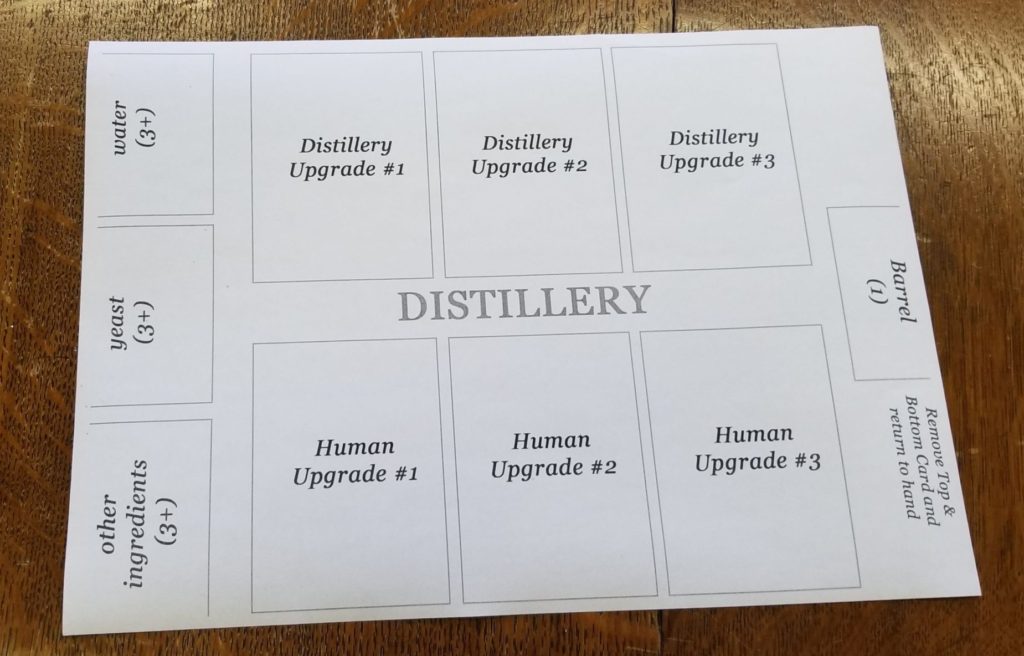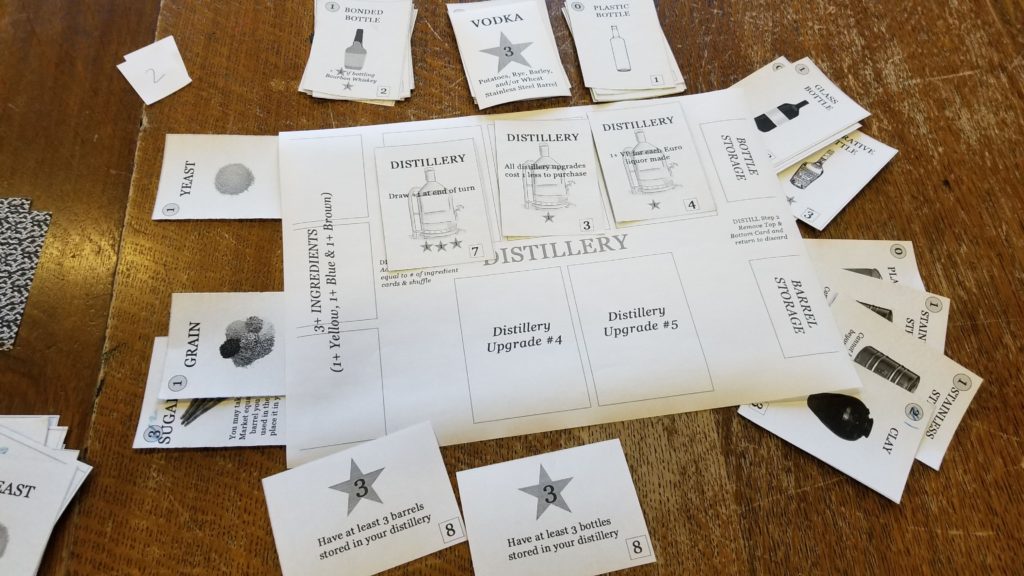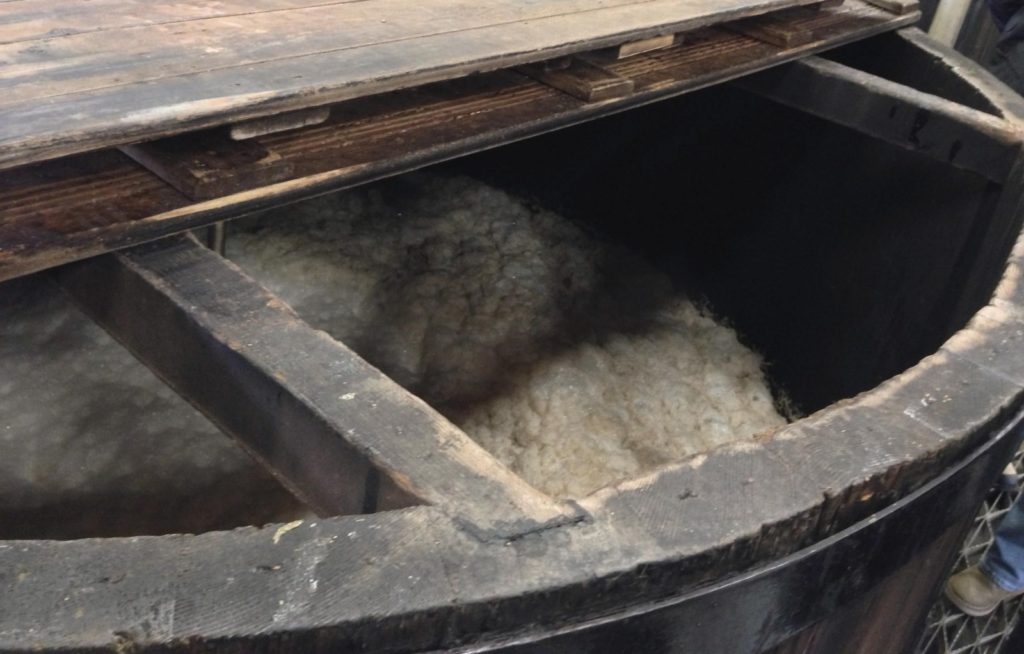From the beginning, Distilled has always had a player board. I knew that I wanted to help each player to feel like they were managing their own distillery, which included the storage of ingredients and items, crafting of spirits, and engaging in the warehouse aging process. Having a background in visual art, and recognizing the importance of “table presence” in the board game experience, I also wanted to strive for something that was aesthetically pleasing to the eye, in addition to it being part of the mechanics.
It began in October of 2019 with some simple goals:
- Represent a “Washback” on the left-hand side of the board, so that players could tuck water, yeast, and sugars underneath the board to represent the ingredients mixing and fermenting in a giant wooden tub.
- Have a “Shelf” to hold Barrels and Bottles
- Have spots for various upgrades to the Distillery where a player could “install” them to build a mini-engine (in this case, both equipment and human specialists)
By December, I had made some adjustments, incorporating a draw and discard pile (remember, this was originally a deck builder!), an attached recipe grid, and some additional details about game end goals (Certificates). Much of the original vision was still there, and in the back of my mind I was still envisioning a trompe l’oeil-esque experience of the player getting to peek into the “dollhouse distillery” that they would get to build throughout the game.
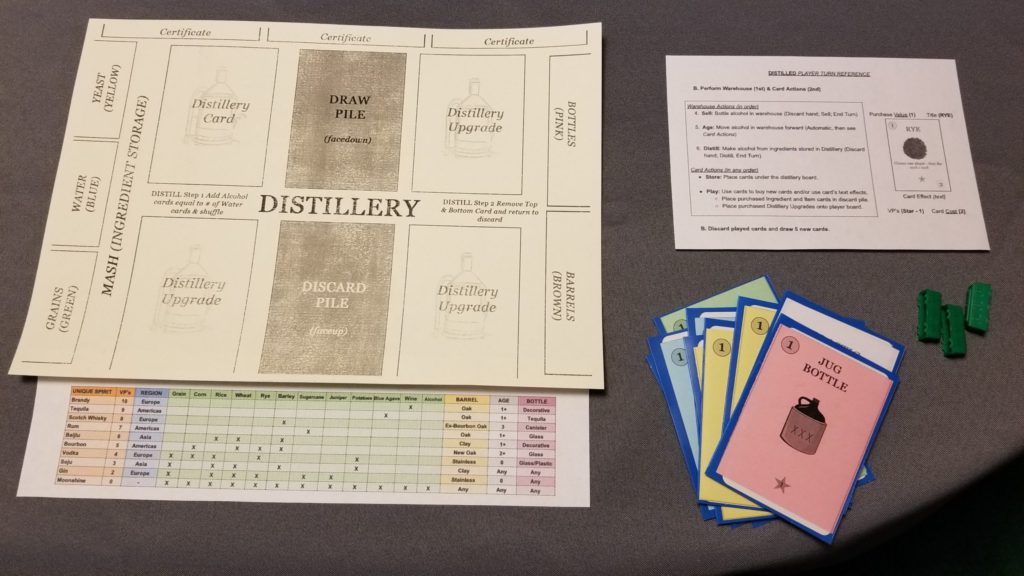
The premise for the game is that you’ve inherited an abandoned distillery, and are trying to bring it back to its former glory. This gave us a great opportunity to work with varying player powers and starting resources, where each player will start with a different distillery founder, who specializes in certain recipes, ingredients, and other powers. This also allowed Erik to do what he does best – come up with some awesome characters that I can’t wait to write backstories for in the coming months!

If you haven’t figured it out by now, I take theme in my games very seriously. I wanted to have the mechanics of the game replicate that of the real-life experience of distilling spirits, whenever possible. Some of the most important and thematic mechanics in Distilled take place in the Washback on the left-hand side of the player board. In real-life, a distillery will take its sugars (corn, barley, rice, etc.) that have been soaking in large amounts of water (this concoction is called the wort) and dump it into a giant wooden tub, called a washback.
They will then add the yeast, which starts the reaction of turning the mixture into alcohol (actually, a sort of beer). I wanted to create this same feeling in Distilled, by players combining their ingredients on the side of their board, to create their recipe right before they distill their spirit. Once those ingredients are added and they are ready to distill, they must let the spirit ferment. Players are required to add a single Alcohol Card for every sugar ingredient (corn, wheat, barley, etc.) that they have in their washback, which causes their deck to grow by a few cards.
It was after play testing the game at Protospiel MN and with various others in-person that I realized I needed to make this part of the board more of a feature using color and shape. I decided to design a curved board to replicate the washback style, and also noticed that there was potential to grow beyond the 8.5 x 11 paper I had been using for my prototype up to that point. By expanding to a size just under 11 x 17, I was able to fit many more things onto the mat, including a player’s own personal warehouse (it used to be a communal warehouse in the middle of the table) and the recipe grid directly on the board. This was a game changer, as it began to feel like a much more personal experience, with some great possibilities for immersive play.
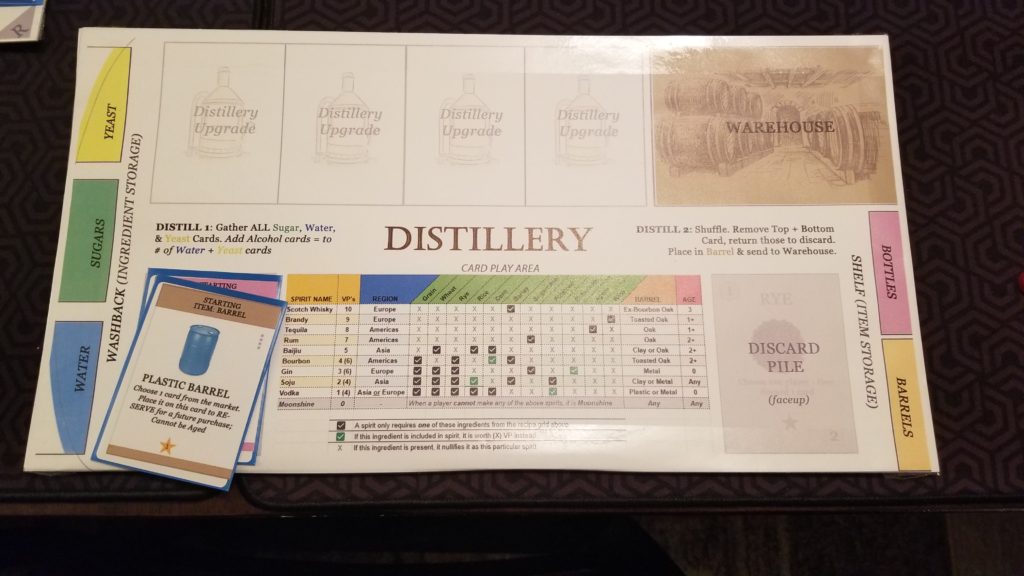
While collecting ingredients in the washback is one thing, the heart of Distilled is of course focused on crafting spirits. Again, I wanted to pay homage to the industry by mirroring what they do in a thematic way through the distillation process as well. When a spirit is distilled, it is brought to a boil in a vessel (such as a still), where the alcohol boils at a lower temperature than water, thus evaporating into the air before the water does. This allows for the alcohol to condense on the inside portion of the still’s arm, and after running through a cooling tank called a worm tub, it turns into a liquid form again.
I knew that I wanted to make the spirit-crafting an integral part of Distilled, and I also wanted to make sure it was fun. While the idea of boiling liquid doesn’t seem that entertaining, there’s one more step to distilling that is actually pretty cool. When this liquid boils and becomes hard alcohol, it actually isn’t all what someone would expect, regarding liquor. The first part of the run off of the still (called the foreshorts or head) is actually undrinkable, and borderline toxic, so the distiller is always sure to remove that portion of the run (but oddly enough, they re-use it in future distillations). The same goes for the final part of the run (called the feints or tails). These are “cut” from the recipe, leaving only the “heart” of the spirit left.
They do all of this using a fascinatingly beautiful and romantic-looking contraption called a spirit safe, where the operator can control the flow of liquid outside of a locked box (historically, this was locked due to making sure nobody was taking personal drams – or entire bottles and barrels – off of the run without the tax-man noticing!).
So, to stay true to them in Distilled, I have each player take the head and the tail cuts from their spirit. Here’s how it works:
- After each player has added alcohol to their batch in the washback, they are instructed to combine everything together into one facedown stack. The spirit has now mixed together and is ready to be distilled.
- Next, the player must shuffle the deck, to represent the boiling and mixing of the concoction, and blindly pull the top card and bottom card from this stack, and return them to their pantry to be used in a future distillation. This represents them taking the head and tail cut of the run.
- Whatever they have leftover is what they have made. If they pushed their luck with only a few cards in the washback, they could be in trouble, resulting in a weak spirit or perhaps even moonshine. But if they took the time to invest in the proper type and amount of ingredients, they could be looking at a very prestigious spirit such as the makings of a single malt scotch whisky!
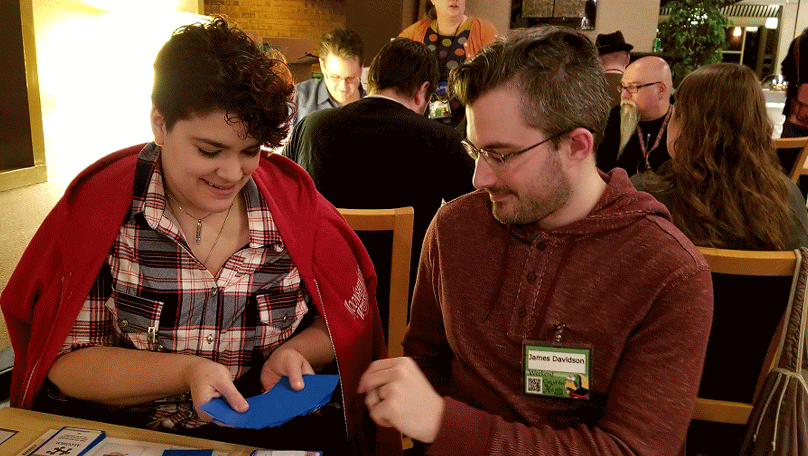
Just as I was really starting to catch some traction with the development of this new board design, the pandemic hit. I was forced to rethink how this game could exist in a digital space, which also allowed me to experiment very quickly and easily with different sized and shaped boards. I decided to drop the recipe grid from the board, and replace it with a more extensive warehouse, to allow the player to keep multiple spirits in the warehouse at the same time.

This was again an important thematic and mechanical part of Distilled. I wanted the players to have a choice between churning out barrel after barrel of cheaper booze – like vodka or gin – or consider longer-term strategies around a fine aged whisky or spiced rum. To do this, I once again tried to marry theme and mechanics. Players interested in aging their spirit would need to wait at least an entire round for it to sit in the warehouse and gain flavor, but in return would be rewarded with higher victory points and interesting flavors.
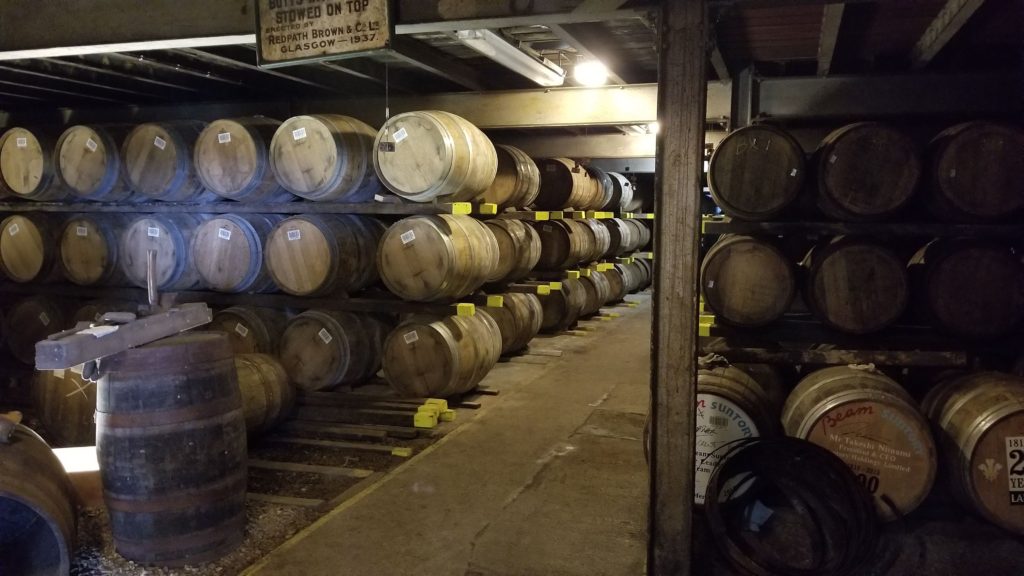
Each time a player chooses to age their spirit, they blindly draw a flavor card and place it facedown on their aging spirit (in their barrel, which is in their warehouse), only to be revealed to the table (and them) when they bottle their spirit in a future round. These flavor cards are always positive, in more money, victory points, or both. This adds a fun surprise element to a player’s spirit, allowing them to describe the flavor profile of their aged spirit to the table!
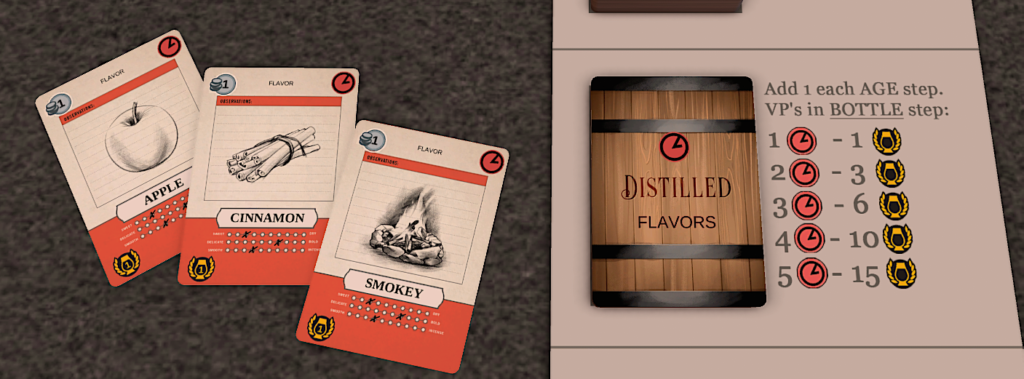
Finally, as mentioned before, I wanted to make sure that the players felt like they were bringing the distillery to life, through the washback, warehouse, and other key features. One of those was incorporating actual people into the mix, where players would be able to “hire” specialists and “install” equipment into their distillery, thus making it an even better well-oiled machine during the game. Thanks to Erik’s amazing talent for character illustrations, he’s already leaned into this one heavily, with a few sneak peeks of these upgrades below.
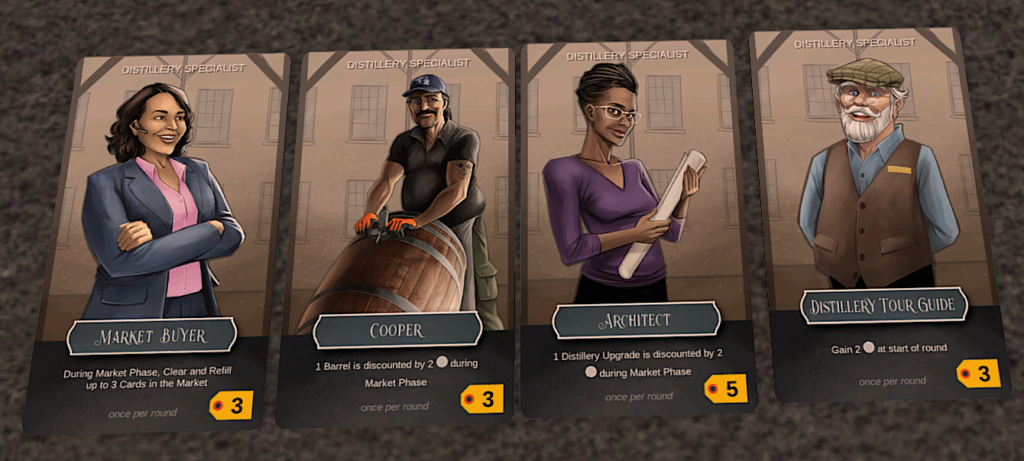
As you can tell, I like to create unique, image-rich experiences for my players. Immersion is key, and it is my hope that a player’s game session will result in photographs that might pop up on social media due to being such a visual treat. I wanted to be sure to allow players to document the spirits they made in each game somehow, so I came up with the “spirit label bonus area” (I know, catchy name) on the top of the player board. This area allows the player to proudly display the spirits they’ve made, but also unlock a one-time bonus as well.

So, with all of these changes and additions, yet a strong tie to theme and experience, I knew Erik had a daunting task in front of him. I wanted something that screamed theme, yet still worked as a mechanical system. I asked him to incorporate other areas such as a “Pantry” to store ingredient cards and storage slots for bottles and barrels. While he isn’t completely finished yet, I’m thrilled about the direction we’re headed, and can’t wait to see the final product!

